Fibropapillomatosis
Download in Dutch
Introduction:
Our sea turtles are facing an unprecedented threat called Fibropapillomatosis (FP). This debilitating disease has been spreading rapidly among sea turtle populations, causing concern among scientists and conservationists worldwide. In this text, we try to explain a bit about Fibropapillomatosis, exploring its causes, impacts, and ongoing efforts to mitigate its effects on these endangered reptiles.
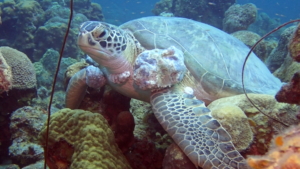
Understanding Fibropapillomatosis:
FP is a viral disease that primarily affects sea turtles, particularly the green turtle (Chelonia mydas). It is characterized by the development of numerous benign tumors, known as fibropapillomas, on the turtles’ soft tissues. These tumors can grow both internally and externally, often affecting vital organs, such as the eyes, mouth, flippers, and internal organs.

Causes and Transmission:
Research suggests that it is associated with a herpesvirus, specifically the sea turtle fibropapilloma-associated herpesvirus (STFV). The mode of transmission is believed to occur through direct contact or exposure to the virus in contaminated water or infected turtles. Environmental factors, such as pollution and compromised immune systems, may also contribute to the development and spread of the disease.
Impacts on Sea Turtles:
FP has devastating consequences for sea turtles. The growth of fibropapillomas can impair their vision, feeding abilities, reproduction and mobility, making them more vulnerable to predation and accidents. These tumors can obstruct the turtles’ airways, making it difficult for them to breathe, and may cause internal organ dysfunction or failure. In severe cases, FP can be fatal.
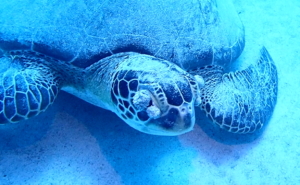
Global Distribution:
FP is not limited to specific regions but has been documented in sea turtle populations worldwide. However, certain areas, such as the Hawaiian Islands, Florida, and the Caribbean, have observed a higher prevalence of the disease. The green turtle population in Hawaii, for instance, has experienced particularly high infection rates, raising concerns about the long-term viability of this endangered species.
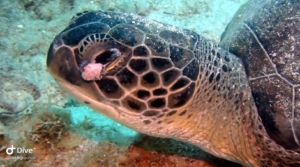
Conservation and Research Efforts:
Given the severity of the disease, scientistsand conservationists have been actively studying FP to better understand its causes, transmission pathways, and effects on sea turtles. These efforts include monitoring infected individuals, conducting necropsies, and investigating potential treatments and vaccines.
Situation in Curacao:
FP has also made its presence felt in sea turtle populations in Curacao. The disease has been observed in green turtles. In hawksbills and Loggerhead turtles, FP doesn’t occur often in the waters surrounding Curacao. This may be due to the difference in food they forage on.. The idea is that green turtles feed on seagrass that is contaminated which weakens their immune system. On average 80% of the population is infected by FP but with almost zero effects because of the overall good health condition. FP will cause severe illness and big tumors in greens who are less healthy and their immuno response to the virus is insufficient.
In another article we will get back to this because this will be the focus of a scientific research program in Curacao starting in june 2023.
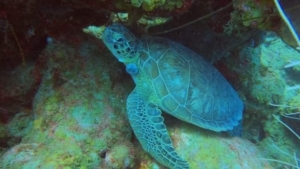
The prevalence of FP in Curacao’s sea turtles has raised concern in STCC and researchers visiting our island. Studies have shown that a significant proportion of green turtles in Curacao’s waters exhibit signs of the disease, with fibropapillomas affecting various parts of the soft tissues of their bodies, including the eyes, flippers, reproduction organs etc.
The exact reasons behind the high incidence of FP in Curacao’s sea turtles are still being investigated. Environmental factors such as pollution, habitat degradation, and compromised immune systems due to stressors like boat strikes or entanglement in fishing gear could potentially contribute to the development and spread of the disease.
STCC tries to monitor and assess the impact of FP on Curacao’s sea turtle populations. In collaboration with international partners, we conduct regular surveys, tagging programs, and health assessments to better understand the disease’s dynamics and its effects on the turtles’ survival and reproductive success.
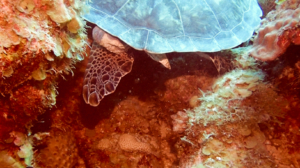
In addition to research and monitoring, STCC initiatives on Curacao aim to reduce potential risk factors associated with FP. These initiatives include promoting responsible waste management practices, implementing coastal and marine pollution reduction strategies, and advocating for the protection and restoration of sea turtle habitats.
By continuing to study the disease, implementing effective conservation measures, and advocating for responsible environmental practices, we can work towards safeguarding the health and well-being of Curacao’s sea turtles and preserving the island’s rich marine biodiversity.
Conclusion:
FP poses a significant threat to the already vulnerable sea turtle population on Curacao. As research continue to investigate the disease and how to treat it, concerted efforts are necessary to mitigate its impact. By protecting the marine environment, supporting conservation initiatives, and promoting responsible practices, we can strive to ensure the survival of these remarkable creatures and preserve the delicate balance of our oceans for generations to come.
Henk Grooten; volunteer STCC








